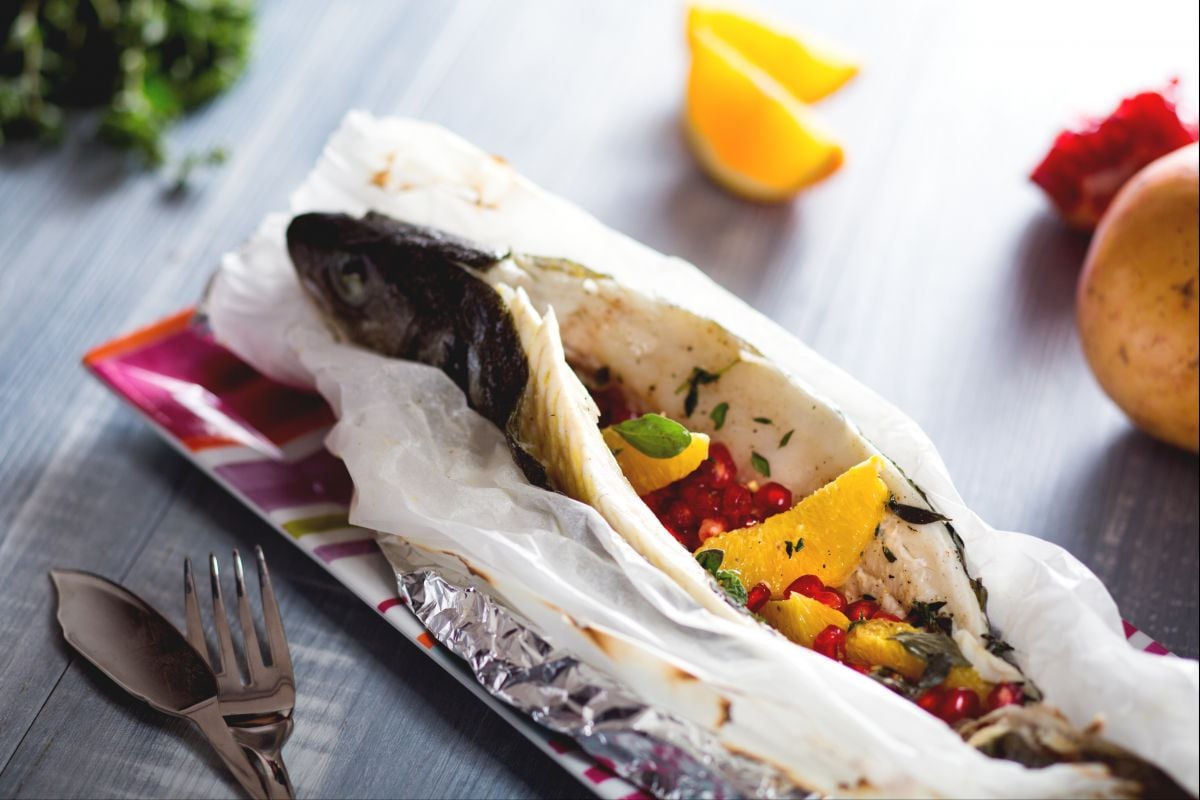Sea bass en papillote with citrus and pomegranate

- Gluten Free
- Lactose Free
- Energy Kcal 178
- Carbohydrates g 6
- of which sugars g 6
- Protein g 31.5
- Fats g 3.1
- of which saturated fat g 0.73
- Fiber g 1.2
- Cholesterol mg 90
- Sodium mg 427
- Difficulty: Easy
- Prep time: 30 min
- Cook time: 25 min
- Serving: 4
- Cost: Average
PRESENTATION
Branzino en papillote is, honestly, one of those dishes you can't forget. And along the coast of Italy, it’s all about simplicity meeting flavor. This traditional method, called 'cottura al cartoccio'—pretty fancy name, right?—is about wrapping branzino in parchment to gently steam it. And let me tell you, it makes the fish tender and juicy, so every bite practically melts in your mouth. Branzino en papillote with citrus and pomegranate gets its flair from fresh citrus slices and pops of pomegranate. So, so good. These ingredients add a blend of tangy, sweet, and fresh flavors that totally complement the fish. Just imagine enjoying this at an Italian seaside dinner. Seriously good.
For those who crave Mediterranean flavors and want to impress without fuss, this baked branzino recipe is perfect. Really, the parchment keeps everything moist, enhancing the fish's natural taste. And the citrus and pomegranate? They add a great spark. Across Italy's coastal regions, you might find small tweaks—maybe a sprinkle of local herbs or olive oil from a nearby grove—but this version with its bright fruit? Stands out. And listen, some folks finish with a scoop of hazelnut sorbet—kind of a surprising choice—which actually complements the fish.
If you want a Mediterranean branzino recipe that’s special yet easy, this is it. The golden edges of the fish, the crispy pomegranate seeds, and the tender flakes make a meal that’s both simple and impressive. And if you’re aiming to bring those Italian coastal vibes to your table, this parchment baked fish is exactly what you need to mix things up. Which is great. Really great.
- INGREDIENTS
- Sea bass (sea bass) 3.1 lbs (1400 g) - (2 fish)
- Oranges 3.5 oz (100 g)
- Pomegranate ¼ cup (40 g) - (the seeds)
- Fine salt to taste
- Black pepper to taste
- Marjoram 4 sprigs
- Thyme 4 sprigs
- Garlic 1 clove
How to prepare Sea bass en papillote with citrus and pomegranate

To prepare the sea bass en papillote with citrus and pomegranate, start by cleaning the fish: with a sharp knife or a descaling tool, remove the scales from the fish placed in the sink (to avoid scattering the scales) 1: run it from tail to head several times until the scales are completely removed. Then transfer the sea bass to a cutting board to gut it: make an incision along the entire back of the fish from tail to head, using a knife: pass the blade to the right and left of the central bone so as to detach the flesh laterally 2. Be very careful not to completely detach the fillets from the fish: the belly should not be cut to allow the fish to open slightly like a book. At this point, make cuts with scissors to the bone on both the tail and head sides 3 so that it can be removed.

Gently pull it outward to remove it 4: with it, you should also remove the internal entrails of the sea bass. Now remove the lateral gills by cutting them with scissors 5. Rinse the sea bass well under plenty of running water, making sure to wash the interior to prevent the bitter taste of the entrails from lingering and to remove any blood residue 6.

Repeat the operation for both sea basses, which you will place on the work surface 7. At this point, prepare the orange: peel it, taking care to also remove the more bitter white part, then slice the pulp to also remove the thin skin that encloses the segments 8. Set it aside. Salt the inside of the fish 9 and add pepper.

Sprinkle the flesh of the sea bass with marjoram and thyme leaves, carefully washed and dried 10. Clean the garlic and cut it in half: place the halves of cloves in each fish 11, along with the orange segments 12.

Divide the pomegranate seeds between the two fillets, still inside the fish 13: the sea bass is now ready to be cooked 14. Place the sea bass on a sheet of parchment paper and close it inside, rolling the ends to secure the parchment paper 15.

Place the fish on a sheet of aluminum foil and wrap the sea bass again inside it, sealing the ends well to prevent them from opening during cooking 16: bake in a preheated static oven at 392°F (200°C) for 25 minutes (if you do not have a static oven, opt for a convection oven preheated to 356°F (180°C) for 15 minutes). Your sea bass en papillote with citrus and pomegranate is now ready to be served and enjoyed 18!